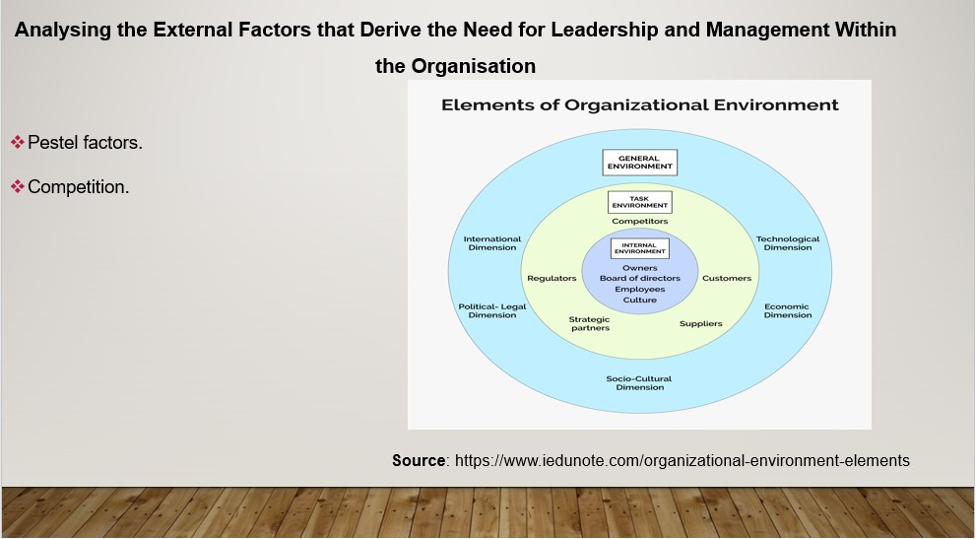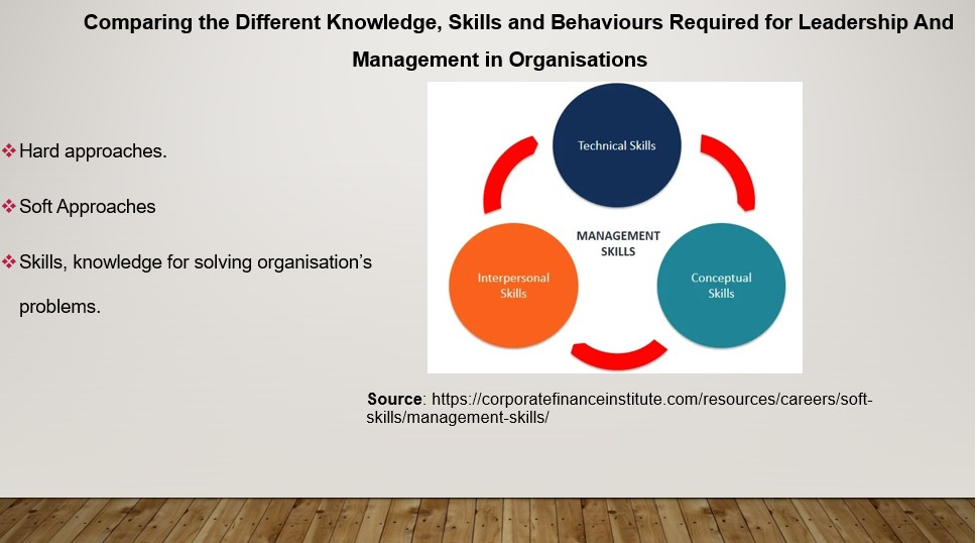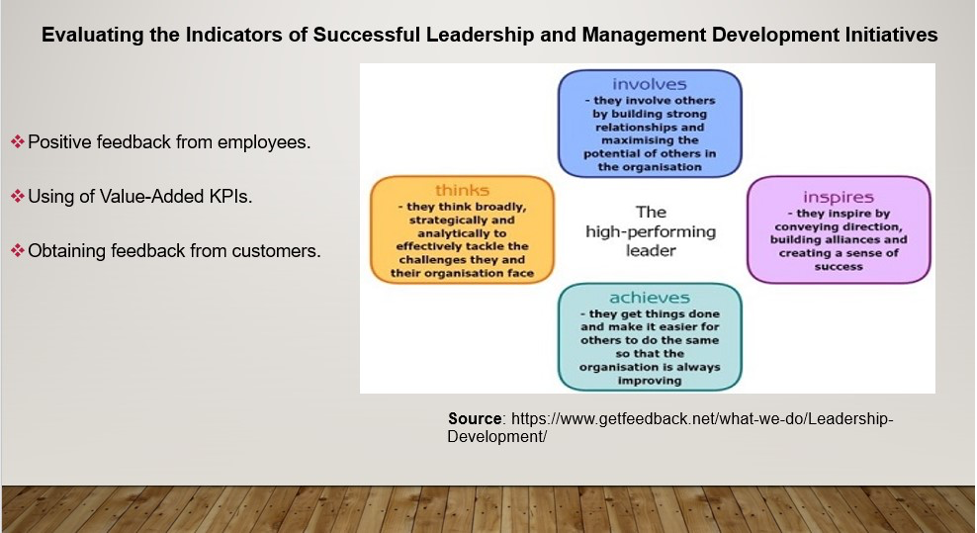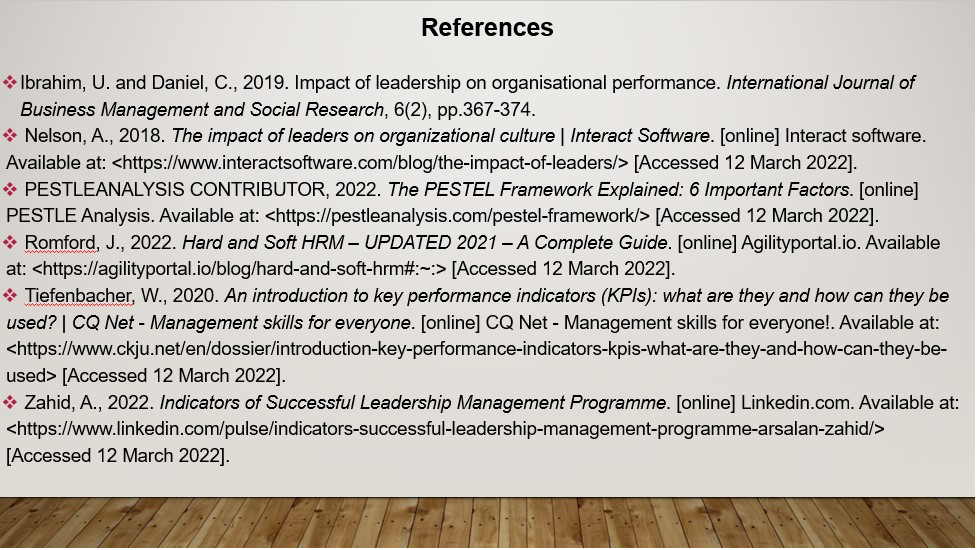Task 1: Research Paper to HR Director
AC 1.2: The Key Differences Between Leadership and Management Roles and Styles and the Implications of Each for Organisational Effectiveness
Leadership is defined as the capacity to influence, inspire, and organise people to achieve corporate objectives (Quilliam, 2021). Inspiration, setting an example, and identifying a vision that is conveyed to others are the three fundamental functions of leadership. Management is the discipline of concentrating on everyday organisational processes to guarantee that a company’s operations operate efficiently and in accordance with the regulations that govern it (Indeed Editorial Team, 2021). Management roles require coordinating many tasks and activities to increase the likelihood of achieving a goal’s success. It also entails measuring activities such as key performance indicators to verify that employees’ productivity levels are sufficient to meet corporate goals. In general, leadership requires persuading people to work together toward a single objective. At the same time, management entails assessing a team’s diverse abilities and personalities and devising the most effective strategies to encourage them. The leadership direction is pursued by a visionary leader who is interested in achieving long-term goals through strategic thinking and planning.
In contrast, the management direction ensures a coordinated workplace environment in which all leaders work toward achieving day-to-day organisational goals. In essence, management is outcome-oriented, focusing on the organisation’s bottom line. Management focuses on developing procedures and structures to improve task performance, while leadership is based on connections with individuals who are meant to fulfil responsibilities.
The four primary leadership styles are transformational leadership, transactional leadership, democratic leadership, and laissez-faire leadership (Cherry, 2021). A leader who practises transactional leadership uses their position of power and lawful authority. A transactional leader’s negotiating power depends on either incentives or threats and punishment.
Transformational leadership understands the need to build motivation and commitment and limits position power and authority (Cherry, 2021). It is founded on the idea that a leader should elicit people’s intrinsic motivation by making them want to do something, as opposed to transactional leadership, in which employees do duties because they are forced to by management. According to quantitative studies, transactional, charismatic, and bureaucratic leadership styles all have a poor association with organisational performance.
The expectation is the major issue with transactional leadership since it is solely based on exchanging objectives and incentives between management and staff. Transactional, bureaucratic, and transformational leadership styles do not motivate people to improve their performance. Rather, they encourage a high rate of turnover. Charismatic and bureaucratic leadership styles have been shown to fit short-term or small initiatives. However, they fail when applied to big businesses with a long-term strategic goal because they do not lead to staff growth, which does not contribute to employee performance.
Organisational success is positively correlated with transformational and democratic leadership styles. Transformational leadership is more successful because it inspires intrinsic drive (Cherry, 2021). Employees’ emotional needs are met by transformational leaders, who also intellectually excite their following. A democratic leadership style is one in which the organisation’s decision-making is dispersed in such a manner that subordinates may also participate. One leadership aspect that increases the odds of employee retention is the leadership style, which fosters employee engagement. Since their leadership style, transformational and democratic leaders have a stronger connection with their workers because praise and criticism are delivered honestly, and employees are involved in a manner that meets their emotional requirements.
Scientific management is based on Taylor’s Scientific Management Theory, which states that breaking down and simplifying activities for workers is the most effective strategy to maximise efficiency and output (Caramela, 2018). Employees’ capacity to conceive and create solutions to work issues and their aptitude to work with minimum supervision are not recognised by the management style. Scientific management stifles creativity and innovation since it hinders workers’ autonomy. Scientific management is based on the concepts of autocratic management, which employs overt techniques such as threats, punishment, and merciless exploitation to guarantee employee cooperation. Employees are unlikely to be motivated to work in an atmosphere that is not genuinely engaged. To a lesser degree, only unskilled and semi-skilled employees who do monotonous activities may benefit from the strategy. Applying an authoritarian management style to a competitive corporate environment with highly qualified personnel who understand what creates a positive work environment is unproductive. Organisations that operate under such a bureaucratic framework may struggle to compete in a dynamic corporate climate when innovation and originality are limited to management.
AC 2.1: Discuss the Role of People Professionals in Supporting Leadership and Management Initiatives
When it comes to supporting leadership and management activities, the two most important roles that people professionals perform are identifying learning and development requirements and identifying, analysing, and supporting leadership and development (Jouany, 2022). The human resource functions performed by people professionals are designed to provide a link between the organisation’s management and its personnel. The purpose of having people experts in a company is to capitalise on their knowledge and experience, which is critical in establishing an atmosphere where managers and workers may advance their careers. Human resources is in charge of leadership development when it comes to an organisation. As a result, those working in the HR department are tasked with developing leadership development programmes and effective upper-level management to support them while also encouraging their subordinates to participate in them.
People professionals evaluate new initiatives and possibilities in the context of leadership and management during a skills requirement assessment (Quilliam, 2022). In order to identify the skills gap, the professionals use the RAM approach, which is a relatively simple framework for maintaining a proactive attitude toward learning and development within an organisation. Using the RAM approach, the professionals identify the skills gap. As part of the method, relevance is evaluated by assessing how the new learning will link back to current issues or opportunities inside the business. Alignment is evaluated by taking into account existing learning and development activities and existing corporate values. Human resource professionals identify an organisation’s learning and development needs to ensure that when management invests resources in leadership and management projects, the programmes that support those projects are aligned with both internal and external organisational drivers.
When it comes to recognising, analysing, and supporting leadership and development, human resources may engage in a variety of activities to assist in discovering and identifying particular areas of weakness among its leaders (Quilliam, 2022). Tests and exams are included in the activities, and participants might also be instructed on how to utilise self-test devices for self-reporting. Human resources might subject personnel to performance appraisals to examine how well the organisation’s leaders are doing in relation to predetermined objectives. Assessment centres can also conduct assessments of past learning. Human resource specialists plan, manage, and coordinate leadership mentoring, individual development planning, and career counselling for their organisation’s workforce.
AC 2.2: Evaluate the Different Concepts and Range Of Approaches that are Available for Effective Leadership and Management Development
Human resource development is built on leadership and management principles. There is a need to help human resource professionals better grasp the ideas and practices that are critical to attaining leadership management success in the workplace (Doyle, 2019). To improve their effectiveness in leading people and managing organisations, leaders may choose from various ideas and methodologies that can be explored. When it comes to leadership and development, organisations may use both formal and informal methods. A common strategy is called secondments, which comprise a work arrangement in which workers are cycled among various departments within the same business to learn how to perform in different positions under different leaders and teams. The primary goal of secondments is to expose leaders and individual contributors to various diverse experiences while also fostering the development of new ties within the organisation. Leaders gain new skills and expertise by working in various jobs, which allows them to expand their knowledge and increase their capabilities. Leadership abilities are developed via practical experience, which is critical for leaders in their current roles and roles to come. Additionally, corporations may conduct on-the-job training, allowing employees to acquire new skills specific to the company while still on the job.
Coaching and mentoring are other successful approaches that organisations may use to grow their personnel (BrightHR, n.d.). Involve individual talks that are necessary to improve knowledge and performance concerning certain skills and objectives. When it comes to coaching in the organisational environment, the challenge is that only a few professionals are qualified to fulfill the function of a coach, and coaching can only be effective when there is a high degree of trust established between the coach and the coach learners. Therefore, finding a qualified coach for a business may become a challenge at times for the organisation. Mentoring, rather than coaching, is regarded as a long-term solution to leadership and management difficulties in an organisation that will last for a lengthy time. It is a two-way learning strategy in which both the mentor and the mentee exchange their expertise and experiences to develop both individuals involved in the relationship. Leaders with a lot of experience are excellent mentors. Mentors use various approaches, including functioning as an assessor, demonstrator, stimulator, or instructor, among other things. Mentorship programmes are widely regarded as the most effective leadership development programmes that an organisation can provide for its employees. This is because they provide a single point of contact for employees to seek clarification and receive support regularly for their current jobs and assist them in making career transitions.
A business may also take advantage of educational-based programmes by using formal courses, vocational education, and management education to address the learning requirements of employees while also allowing them to achieve certifications (Veal and Dunbar, 2018). The core of formal credentials for leaders and managers is that they provide an avenue for professional development by allowing them to participate in approved training programmes, which third-party organisations often provide. A variety of educational courses are available to leaders, each of which may assist them in meeting their unique development requirements. The approach is suggested for businesses because it enables leaders to improve their skills and knowledge via a formal approach that follows an accepted and credible technique and includes a set of learning materials. Educational-based programmes are time-consuming and resource-intensive, and as a result, they are only appropriate for large businesses that can dedicate significant financial resources to the programmes. Essentially, the insights gained from the theories and models stated above are significant in leadership and management because they provide companies with chances to increase learning effectiveness, which influences the learning environment. The most difficult task for leadership and development practitioners is to examine the many theories available and choose which ones are most appropriate for their particular organisation setting.
AC 2.3: Discuss Why Diversity and Inclusion Should Be an Integral Component of Leadership and Management Initiatives
Diversity is an integral part of leadership and management initiatives because it enables leaders to create an accommodative environment for inclusive cultures characterised by a collective agreement and set of behaviours that unite diverse identities, which enriches an organisation as the source of insights and unique skills (Black, Gardner, Pierce and Steers, 2019). Under the globalisation era, organisations operate in an environment in which it is almost impossible to survive without a diverse workforce because it is a legal policy in most countries, and even without the legal aspect, minorities exist in every society, and it is a good management practice to accommodate them and tap on their resourcefulness. Leadership that embraces the principles of diversity and inclusion in its HR practice effectively manages teams by fostering cohesion which is essential in nurturing cooperation and collaboration among members when performing towards a common target.
Diversity and inclusion in HR management enable a leader to eliminate harassment and victimisation of minorities in the workforce; promote equality of opportunity by eliminating any form of discrimination, and nurture good relations between people from different groups (Black, Gardner, Pierce and Steers, 2019). A culture of diversity and inclusion creates inclusive leaders who are more effective because such leaders do not control employees; instead, they engage. Inclusive leaders engage their followers with purpose and vision. Additionally, it is easier for such leaders to establish a rapport with their followers, who perceive them as partners instead of bosses. In case of a problem that needs a solution, inclusive leaders remain responsible and accountable among followers instead of engendering a culture of blame. Such a leadership approach achieves a workplace environment where there is a flow of ideas due to cohesive teams.
In the organisational context, diversity and inclusion are important in enhancing an organisation’s capacity to attract top talent in a competitive recruitment space. Additionally, leaders’ positive attitude towards diversity is important in reducing turnover as it increases employee retention. An organisation that embraces the principle of diversity and inclusion equally benefits an organisation by improving customer experience. The ultimate goal of competent leadership is to coordinate employees to perform organisational activities in a way that translates to a better performance that eventually adds value to the company’s bottom line. Leaders who foster a culture of diversity and inclusion ensure that employees embrace the values and interact with customers in ways that boost their experience. Therefore, diversity and inclusion as a leadership strategy create inclusive leaders who can unleash individual potential by nurturing an environment that enables talent to thrive and grow.
AC 3.2: Explain the range of stakeholders and the involvement they have in leadership and management development initiatives.
Every company has numerous kinds of stakeholders, including main and secondary stakeholders, who are further subdivided into internal and external groups based on their roles. Primary stakeholders are those inside a company who are directly engaged with or impacted by a company’s executives or management decisions (Sedmak, 2021). Examples of major internal stakeholders include the organisation’s staff and stockholders, while examples of primary external stakeholders include consumers and shareholders. Secondary stakeholders are those whose activities are not directly related to the operation of the company but who are affected by the organisation’s actions as a result of their actions. Secondary internal stakeholders consist mostly of suppliers, and secondary external stakeholders consist primarily of members of the general public.
In every business, stakeholders have a significant impact on the decision-making process. In the majority of situations, stakeholders from various sectors are represented on the board of directors, where they exert influence over leadership actions with the goal of increasing productivity. Involved stakeholders with the ability to disrupt choices have the ability to do so by making certain that the organisational work environment stays dynamic, exciting, and rewarding to workers. Higher-level decision-makers are influenced to the degree they can appoint and dismiss top executives from their positions.
References
Black, S., Gardner, D., Pierce, J. and Steers, R., 2019. Diversity and Its Impact on Companies. [online] Opentextbc.ca. Available at: <https://opentextbc.ca/organizationalbehavioropenstax/chapter/diversity-and-its-impact-on-companies/> [Accessed 12 March 2022].
BrightHR, n.d. What are the benefits of coaching and mentoring in the workplace?. [online] BrightHR. Available at: <https://www.brighthr.com/articles/training/coaching-mentoring/benefits-of-coaching-and-mentoring-in-the-workplace/#:~:text=Coaching%20and%20mentoring%20an%20employee,increase%20their%20loyalty%20to%20you.> [Accessed 12 March 2022].
Caramela, S., 2018. [online] Business.com. Available at: <https://www.business.com/articles/management-theory-of-frederick-taylor/> [Accessed 12 March 2022].
Cherry, K., 2021. What Are Prominent Leadership Styles and Frameworks You Should Know?. [online] Verywell Mind. Available at: <https://www.verywellmind.com/leadership-styles-2795312> [Accessed 12 March 2022].
Doyle, L., 2019. Leadership Styles: 5 Common Approaches & How to Find Your Own. [online] Northeastern University Graduate Programs. Available at: <https://www.northeastern.edu/graduate/blog/leadership-styles/> [Accessed 12 March 2022].
Indeed Editorial Team, 2021. What Is Management? Definition, Functions and Levels. [online] Indeed Career Guide. Available at: <https://in.indeed.com/career-advice/career-development/what-is-management> [Accessed 12 March 2022].
Jouany, V., 2022. What Are The Top 24 Leadership Skills That Make a Great Leader?. [online] Blog.smarp.com. Available at: <https://blog.smarp.com/what-are-the-top-leadership-skills-that-make-a-great-leader> [Accessed 12 March 2022].
Quilliam, G., 2021. Leadership in the Workplace | Factsheets | CIPD. [online] CIPD. Available at: <https://www.cipd.co.uk/knowledge/strategy/leadership/factsheet> [Accessed 12 March 2022].
Quilliam, G., 2022. Line Managers’ Role in Supporting the People Profession | Factsheets | CIPD. [online] CIPD. Available at: <https://www.cipd.co.uk/knowledge/fundamentals/people/hr/line-managers-factsheet> [Accessed 12 March 2022].
Sedmak, J., 2021. What is Stakeholder Engagement, and Why is it Important for Strategic Planning?. [online] Smestrategy.net. Available at: <https://www.smestrategy.net/blog/stakeholder-engagement-management-for-strategic-planning> [Accessed 12 March 2022].
Veal, K. and Dunbar, M., 2018. Work-Based Learning for Skills Development. [online] Development Asia. Available at: <https://development.asia/explainer/work-based-learning-skills-development> [Accessed 12 March 2022].
Task 2: Presentation Pack on Recommendations
Slide 1 AC 1.1
 The relevance and significance of leadership and management responsibilities in an organisation make it important to invest in leadership and management development efforts. The management should implement certain actions; the organisation has prepared a new working strategy on leadership and management development, which will be implemented shortly. There are numerous components of leadership and management covered by the new strategy, which will be implemented to strengthen common leadership practices. Based on their implications for the organisation and an explanation of some of the realities around how the various possibilities would play out, the decisions on desired changes are justified.
The relevance and significance of leadership and management responsibilities in an organisation make it important to invest in leadership and management development efforts. The management should implement certain actions; the organisation has prepared a new working strategy on leadership and management development, which will be implemented shortly. There are numerous components of leadership and management covered by the new strategy, which will be implemented to strengthen common leadership practices. Based on their implications for the organisation and an explanation of some of the realities around how the various possibilities would play out, the decisions on desired changes are justified.
Leadership styles are influenced by various external elements, including the company’s demographics, employee characteristics, financial resources, economic and political conditions, and technological advancements. When it comes to doing an environmental scan, the PESTEL analysis is a go-to tool (PESTLEANALYSIS CONTRIBUTOR, 2022). An external factor assessment matrix focusing on six data spheres is used in this model. First, there is the realm of politics and economics. Government policies, political stability, trade, and tax policy are among them. Due to economic circumstances, changes in supply and demand directly impact a company’s bottom line. A company’s supply chain, consumers, and rivals must all be studied to understand the marketplace’s present economic and political conditions. In order to achieve their objectives, leaders are influenced by these variables.
The social sphere is the factor affecting leadership in an organisation. Customers’ changing demands and emerging patterns in demographics and consumer behaviour may point to a need for organisational transformation. Organisational leaders must know their customers’ demographics and cultures, and current trends in the market to tailor their goods and services to meet the needs of certain demographics.
The technical component is the third sphere. This involves how new product and process development transforms the market or industry. It also involves automation, technological adoption, and new services or goods. The corporate environment may be transformed by technology, and to assist the organisation in keeping pace with technological advancements, leadership must modify their management techniques. Innovative new methods may be developed via research and development.
Fourthly, there is the environmental issue: An organisation’s operations or customer demand are impacted by environmental and ecological factors. Companies have their own unique culture and values, shaped by both their history and present leadership. These values embody the leadership commitment to its stakeholders, such as workers, shareholders, community, and the customers, to guide in the company’s operation. This personality is determined by the aims, beliefs, and concepts that shape the products and services that people buy and use.
Finally, there is the matter of legality to consider. A company’s present legal rights and obligations in the nations and regions it does business. Health and safety regulations, labour laws, and consumer protection legislation are all included in this category. Employees in an organisation are characterised by the duties and responsibilities they are expected to carry out in relation to their coworkers. The kind of leadership needed to guide an individual depends on how mature their attitude toward work and relationships is. Both the work ethic and personal convictions of an employee may affect a company. In order to assist employees in completing their jobs, leaders must be aware of and take steps to minimise the traps and bottlenecks inherent in each role.
The process of learning and development is another important consideration. Throughout the years, learning and development programmes have evolved, necessitating the need for problem-solving skills rather than just delivering information. In these types of situations, training and development of leadership and management skills become essential. In addition to the ones mentioned above, various elements substantially impact organisational learning. The overarching aims of leadership and management development have evolved to include supporting outstanding leadership, concentrating on well-being as a default result, and offering assistance in developing interpersonal connections.
The competitive environment exacerbates the necessity for leadership and management development. Most of the time, competition is connected with organisational transformation, which is a primary driver of the demand for leadership and management development programmes. Without competition, the organisation would be unmotivated to adapt to changes in the external business environment, which would be detrimental to its long-term success.
Slide 2 AC 1.3
 The human resource management role is divided into hard and soft approaches (Romford, 2022). The hard approach to human resource management in the organisation is based on seeing personnel as sources of revenue, just as the company’s tools and machinery are seen as sources of revenue. A major focus of the hard approach is on operational duties like planning, establishing organisational structures, and tracking performance results. People-friendly management approaches that are grounded on emotions are referred to as soft approaches. It includes relationship-focused behaviours such as respect for workers, appreciation for employees’ ideas, increasing cohesion, and mentoring employees.
The human resource management role is divided into hard and soft approaches (Romford, 2022). The hard approach to human resource management in the organisation is based on seeing personnel as sources of revenue, just as the company’s tools and machinery are seen as sources of revenue. A major focus of the hard approach is on operational duties like planning, establishing organisational structures, and tracking performance results. People-friendly management approaches that are grounded on emotions are referred to as soft approaches. It includes relationship-focused behaviours such as respect for workers, appreciation for employees’ ideas, increasing cohesion, and mentoring employees.
In order to effectively practice both approaches to leadership in an organisation, specific skill sets for the execution of distinct responsibilities would be required. Management competencies such as integrity, emotional management, and a considerate approach to leadership are some of the categories of management competencies that should focus on the organisation’s leaders. Respectful and responsible management of employees is one of the categories of management competencies on which leaders should concentrate their efforts. In order to manage and communicate the current work plans, a productive work environment, problem-solving abilities, and a participatory attitude to dealing with others are required to be successful.
Skills for thinking and handling challenging circumstances are also essential. They include conflict management talents, making efficient use of organisational resources, and accepting responsibility for resolving problems. As an individual manager within a team environment, being available, sympathetic participation, and social connections are essential. As a result, the organisation’s leaders and managers must strengthen their emotional intelligence skills. It is vital in leadership techniques such as conflict resolution, encouraging excellent personal judgments, and inspiring others to have high levels of emotional intelligence. Self-awareness, drive, influence, emotional resilience, conscientiousness, and interpersonal sensitivity are some of the particular qualities linked with emotional intelligence.
Slide 3 AC 3.1
 The majority of practitioners in leadership and management learning and development programmes are worried about their grasp of the implications of the learning process. As a result, the outputs of the learning process are often linked to the objectives and efforts of the organisation’s growth. As a result, the effectiveness of organisational leadership and management initiatives may be measured using a variety of metrics. In many cases, measures are taken via observations, feedback from workers and customers, and evaluations of the return on investment connected with leadership and management development programmes (Zahid, 2022).
The majority of practitioners in leadership and management learning and development programmes are worried about their grasp of the implications of the learning process. As a result, the outputs of the learning process are often linked to the objectives and efforts of the organisation’s growth. As a result, the effectiveness of organisational leadership and management initiatives may be measured using a variety of metrics. In many cases, measures are taken via observations, feedback from workers and customers, and evaluations of the return on investment connected with leadership and management development programmes (Zahid, 2022).
One of the indicator categories is employee participation and satisfaction, which includes positive feedback from the employees. Feedback might be gathered via surveys and interviews, and the results could be used to establish the general level of satisfaction among executives and staff. Another collection of key performance indicators that might be used to assess the effectiveness of leadership and management initiatives in an organisation is value-added KPIs (Tiefenbacher, 2020). The greatest way to get information about value contributed KPIs is to observe how leaders behave in the workplace. Obtaining feedback from customers may also be beneficial in the decision-making process. Individual performance data might also serve as another kind of indication for the quality of leadership and management development programmes – Individual performance evidence may be directly tied to organisational goals and objectives, or it may be directly linked to the outputs of workers based on individual key performance indicators (KPIs).
Slide 4 AC 3.3
As visionaries and strategic thinkers, L&M impacts the culture of the organisation (Nelson, 2018). Leading with a vision that people believe in and a plan that they understand will help to build an environment of engagement. Every employee is aware of the company’s direction, how it intends to get there, and their role in assisting in achieving the mission. Embracing ethics that promote ideals is the second way to go about things. It is your actions, not your words, that are scrutinised. When it comes to values, words matter; when it comes to ethics, deeds matter. Leadership by example and creating an ethical culture occur when leaders display ideals through their behaviour. In the third place, you might be more empowered. Leading at all levels of an organisation requires leaders who empower people to make choices that touch their own lives, give them the authority to act, and accept responsibility for the consequences. The practice of micromanaging results in individuals not being trusted to be leaders, and as a result, nothing is accomplished since a single individual must make all decisions.
Leadership and management development programmes also have an influence on the organisation’s strategies by enhancing employee motivation and engagement (Ibrahim and Daniel, 2019). The training may aid in the development of managerial flexibility, pliancy, and resilience, all of which are essential in developing a sustainable workforce that can turn adversity into an advantage. Some of the particular benefits of leadership and management development efforts include higher productivity, the development of future leaders, and enhanced company culture, and the ability to handle change effectively, among other things. In addition, enough assistance should be provided to new leaders for them to be able to put the theory they have learned into practice inside the organisation. They also have a responsibility to ensure that the changes implemented at the organisational level are sustained, and they need a support structure and process to do so successfully. It is vital to have a mentor who will assist the learner in integrating the concepts they have learned into their working environment.
Leadership and management development are necessary for every organisation, given the continually changing business environment. Such development activities are often focused on optimising the influence of organisational leadership on people, aligning individual managers’ objectives with those of the organisation, achieving defined performance targets, and meeting personal key performance indicators (KPIs). As a result, the indicators and ways to managing effectiveness in leadership and management training are chosen in accordance with the goals and objectives of the organisation.
Slide 5: References




